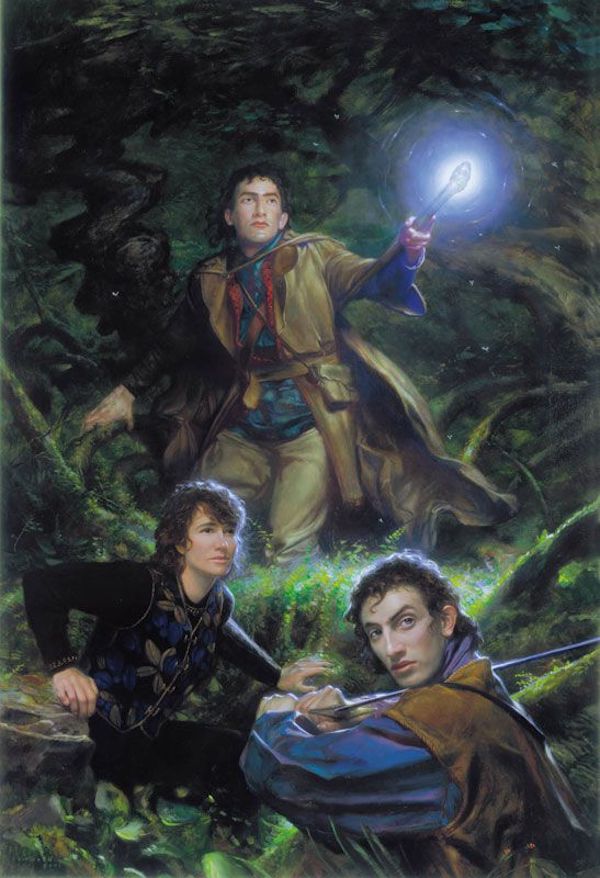Hobbits, amirite?
When they’re not avoiding anything that makes them late for dinner, they’re pilfering ancient artifacts, accepting age-ending quests, sticking with their friends through thick and thin to the bitter end, testing the patience of wizards, getting kidnapped by Orcs, befriending tree-shepherding giants, sitting on the edge of ruin while discussing the pleasures of the table, swearing their service to kings, stabbing smack-talking lords of carrion and voracious giant spiders…and even carrying their masters up the faces of active volcanoes. Hobbits are, when it comes down to it, just a bunch of irrepressible lads and lasses going off into the Blue for mad adventures.
And a lot of people are very fond of them. Accordingly, on September 22nd, the in-world birthday of both Bilbo and Frodo Baggins, we celebrate Hobbit Day. It’s Tolkien Week, in fact, which has been a thing since 1978. Far too short a time.
Now, this is not really an essay, just an opportunity to share my own fondness for the species that gave J.R.R. Tolkien’s first book its title and when on to become a foundation to the snappy sequel that followed.
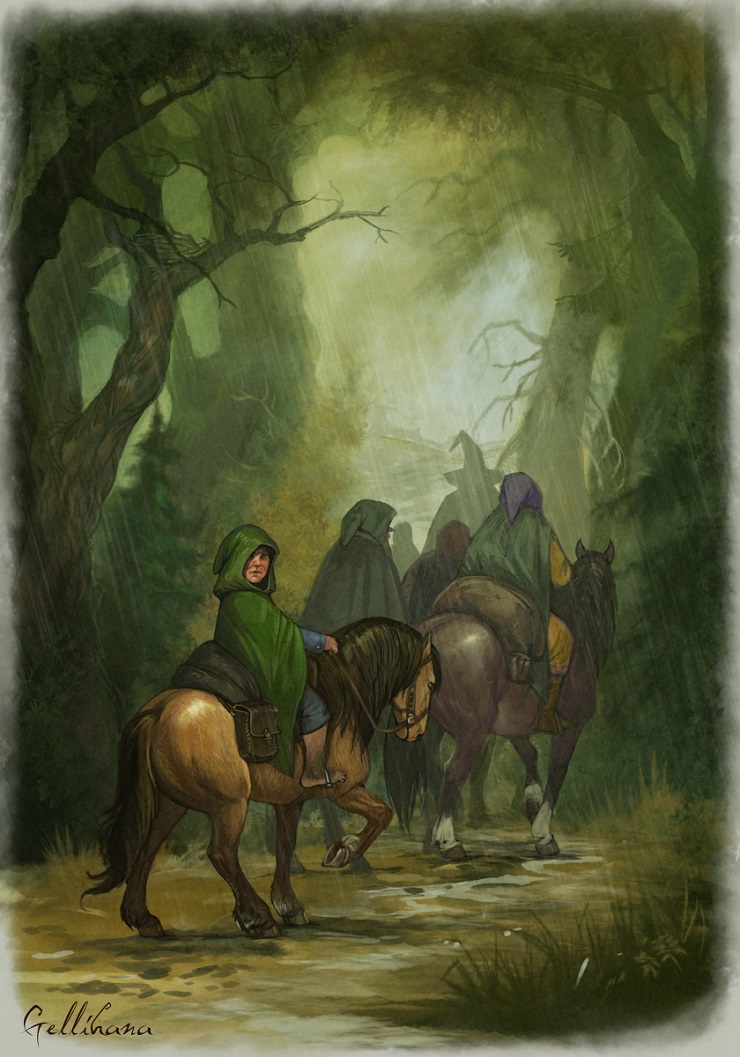
Well, okay, maybe also a very short look at their past. So just where are Hobbits in the big picture?
Those who explore The Silmarillion and the extended legendarium learn that Arda—that is, the entire world, of which Middle-earth is but a continent—was made for the Children of Ilúvatar. Ilúvatar is essentially God in Arda and the Children are both Men and Elves. This is their habitat, for different lengths of time. Dwarves were shoehorned into this two-race scheme when one of the Powers that preside over the world fashioned them (without permission) but then got conditional approval for them to stay around. Ents and Eagles…let’s call them special projects of the aforementioned Powers. Then you’ve got Orcs, trolls, dragons, and other monsters, all of which stem from various R&D projects under the management of the first Dark Lord, made in mockery of those above with the goal of destruction.
Okay, so where are Hobbits in all this? Tolkien famously didn’t tie everything up neatly in his secondary fantasy world by the time of his death—allowing all of us, I suppose, to talk and debate the matter. I think most would conclude that Hobbits are connected to Men and therefore share in their long-term fate: they live for a relatively short span of time (compared to Dwarves and certainly to Elves) before passing beyond the Circles of the World. Which means they’re more like us than any other fantasy race.
In “Concerning Hobbits,” the prologue of The Lord of the Rings, we’re told…
The beginning of Hobbits lies far back in the Elder Days that are now lost and forgotten. Only the Elves still preserve any records of that vanished time, and their traditions are concerned almost entirely with their own history, in which Men appear seldom and Hobbits are not mentioned at all. Yet it is clear that Hobbits had, in fact, lived quietly in Middle-earth for many long years before other folk became even aware of them.
No kidding. Two long ages go by without any mention of Hobbits. If they developed from the family tree of Men, we’re not privy to the specifics. In this way they may be like the Woses, the Wild Men of the Woods, who are certainly human but time or happenstance have given them different physical characteristics. Anyway, it’s not until the year 1050 of the Third Age—note, well after Sauron’s loss of the One Ring—that anyone even wrote an account of the Hobbits’ existence, though Elves, Men, and Dwarves each kept track of their own triumphs and disasters.
Buy the Book
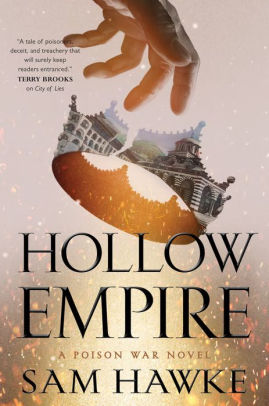

Hollow Empire
And even then, it was only upon the coming of the some Hobbits into Eriador that some noticed and thought to put pen to paper. These were their Wandering Days, their slow migration from the “upper vales of the Anduin, between the eaves of Greenwood the Great and the Misty Mountains.” There were the three basic branches of Hobbit-kind: the river-loving Stoors, the artsy and Elf-friendly Fallohides, and the hill-dwelling Harfoots. Interestingly, we’re told that it was due to the increase in the numbers of Men near them “and of a shadow that fell on the forest” (i.e. Sauron as the Necromancer settling into Dol Guldur) that prompted them to migrate westward.
The agrarian Hobbits eventually settled in some little-used lands in the wide Dúnedain kingdom of Arthedain. In the wars against Angmar and its ruler, the freakin’ Witch-king himself, we’re told that Hobbits contributed some archers once, “or so they maintained, though no tales of Men record it.” So they were there for a thousand years, minding their own business and never doing anything unexpected. Yet when old Witchy and his eight fellow riders go hunting for someone called “Baggins” in a placed called “the Shire,” well, it takes them a while. They’ve never heard of the place. They had to ask around, after all. Nevermind the fact that they once terrorized Eriador and ran roughshod over folks in the region for their boss.
So yeah, without even trying, Hobbits keep a low profile.
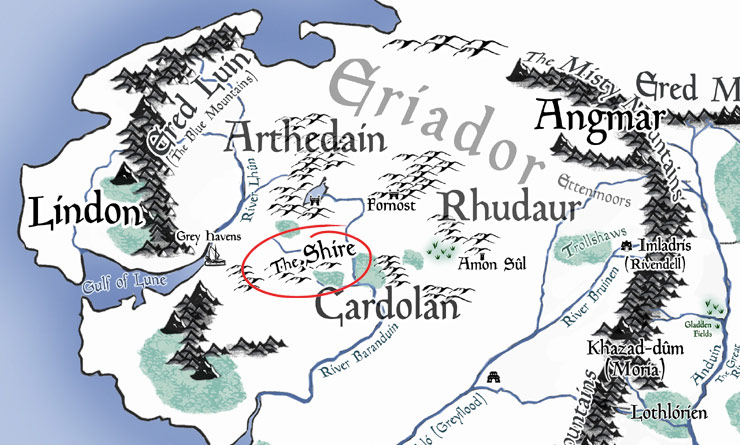
And when they actually try to stay hidden, they do a pretty good job of it. Bilbo might have famously botched his first burglar job, but that’s what being 1st level is like for any adventurer. He got better. And of course, the magic item he pocketed later helped in the stealth department. But Hobbits are naturally unobtrusive. Inconspicuous.
They possess from the first the art of disappearing swiftly and silently, when large folk whom they do not wish to meet come blundering by; and this art they have developed until to Men it may seem magical.
Almost as if by design, or by chance—if chance you call it. But it’s also a social trait, at least outside of the Shire and Bree-land where Hobbits are little more than a rumor. Denethor is amused by Pippin in Minas Tirith, but is hardly impressed. Théoden is genuinely appreciative of Merry but dismisses the idea of him riding to war.
‘And in such a battle as we think to make on the fields of Gondor what would you do, Master Meriadoc, sword-thain though you be, and greater of heart than of stature?’
Merry goes to war, anyway, with Éowyn’s help. And he suffers for his valor, yet he is overlooked in the ruin. While the bodies of the living and the dead are carried from the Pelennor Fields, Merry basically limps himself up into the city, stricken by the Black Breath, where it takes another Hobbit to notice him and steer him to the Houses of Healing.
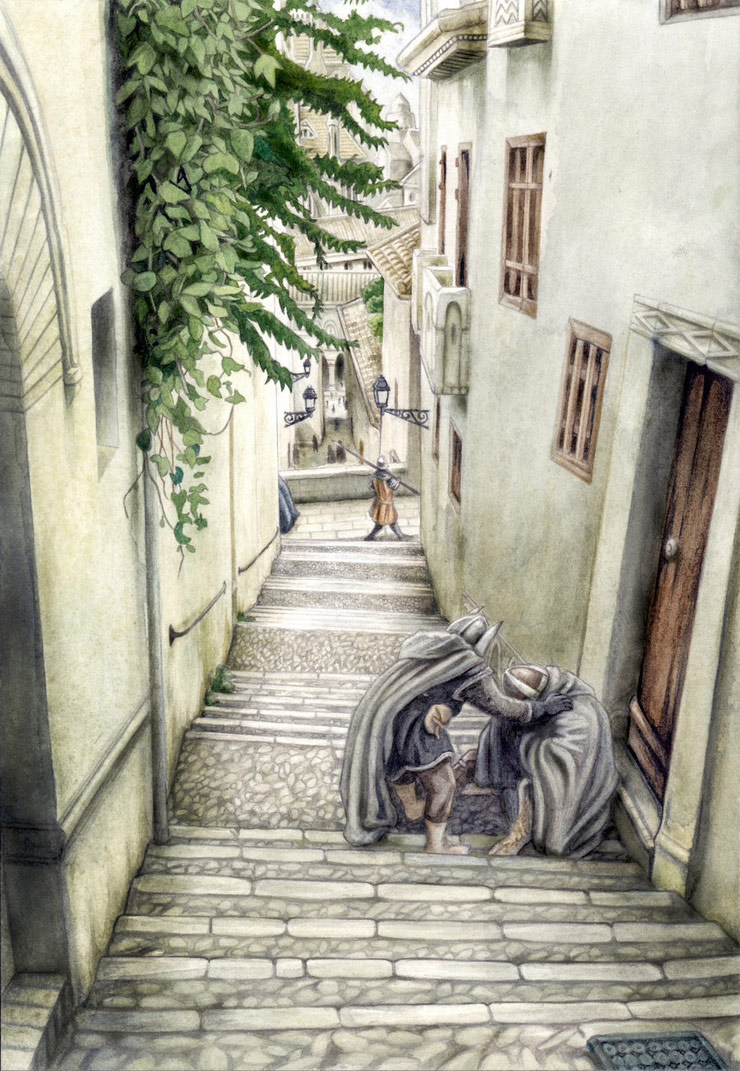
Hobbits are tough as hell. “Concerning Hobbits” also informs us:
They were, if it came to it, difficult to daunt or kill; and they were, perhaps, so unwearyingly fond of good things not least because they could, when put to it, do without them, and could survive rough handling by grief, foe, or weather in a way that astonished those who did not know them well and looked no further than their bellies and their well-fed faces.”
Here is the great irony. Hobbits are beneath the notice of so many, right? We see it with the good guys and the bad guys alike. The Elves in Lothlórien know of them, but thought them long gone from Middle-earth (say, was Galadriel keeping her people in the dark about them?). To the Men of Rohan and Gondor they are halflings, “little people in old songs and children’s tales.” The three trolls don’t know what Bilbo is. Smaug’s never smelled one before. The Ringwraiths are sent to discover them because they’re an unknown quantity to their master. Sauron overlooks Hobbits big time, to his own uttermost ruin. Even Saruman, who at least knew about the Shire for far longer than his secret rival in Mordor, couldn’t be bothered with them until it was too late.
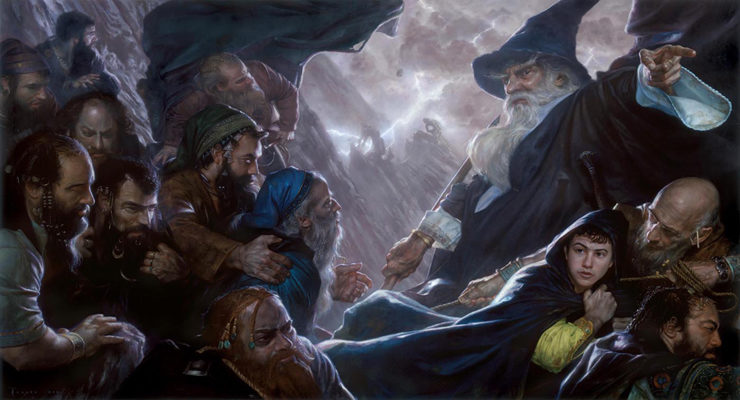
YET…
Yet we, Tolkien’s readers, find Hobbits anything but inconspicuous. They are the story. They are our eyes on the wonders and terrors of Middle-earth outside their borders. And almost every fan’s got their favorite Hobbit. I always want to default to Sam—of course I do: heroic, stubborn, loyal Master Samwise with all his folk wisdom and surprising spikes of empathy—but on some days it’s Merry or Pippin or even Frodo who takes the cake.
And Bilbo? Come on! And some part of me wishes the Tolkien Estate could hurry up and unearth The Lost Adventures of Belladonna Took and publish it already. And even Lobelia Sackville-Baggins has an entertaining character arc. And I always wish we knew more about Rosie Cotton. I wish Sam talked about her more throughout the dangerous quest to Mount Doom (but then that wouldn’t be like him, would it, as he is always sensibly concerned with Frodo’s well-being and their mutual survival?). At least Sam gets the ending he deserves.
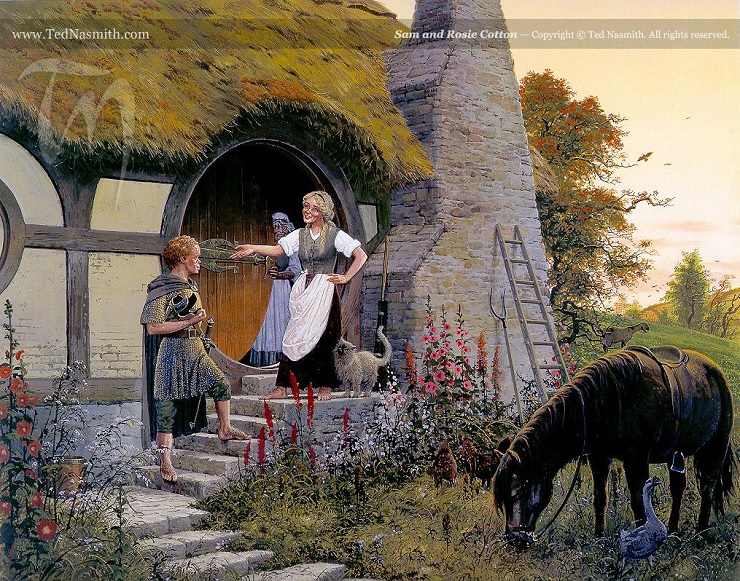
For us, Hobbits don’t go unnoticed. For all that I love Tolkien’s most famous book, if you strip away Hobbits you’ve got a very different story that would still be beautiful and lofty—but it would be bereft of its heart. It would be less memorable. After all, everybody knows that Thorin Oakenshield speaks the truth when he says…
‘If more of us valued food and cheer and song above hoarded gold, it would be a merrier world.’
This is a given, right?
But oh, I mustn’t leave out mention of one particular fellow that it’s easy to forget is (or was) something like a Hobbit himself. As Gandalf explains…
‘I guess they were of hobbit-kind; akin to the fathers of the fathers of the Stoors, for they loved the River, and often swam in it, or made little boats of reeds. There was among them a family of high repute, for it was large and wealthier than most, and it was ruled by a grandmother of the folk, stern and wise in old lore, such as they had. The most inquisitive and curious-minded of that family was called Sméagol.’
It doesn’t seem fair to leave Sméagol entirely out of the discussion, since it was his greed—and his single-minded obsession with the Precious—which drastically altered the course of history in Middle-earth. Twice in particular: when he first acquired it and when he regained it.
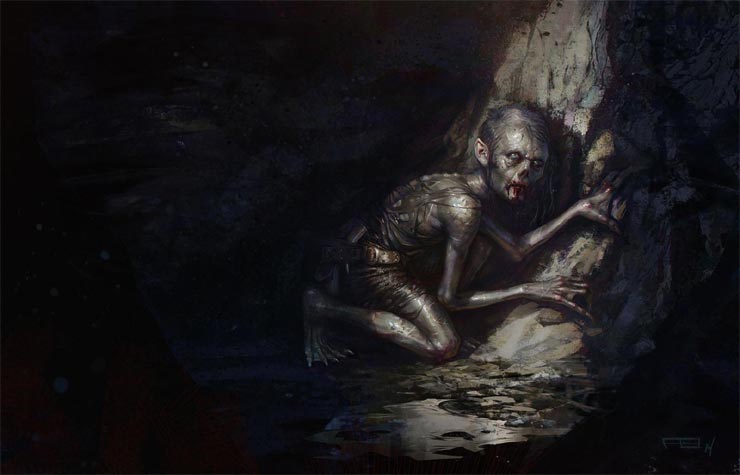
And he endured for so long—living for hundreds of years, with the Ring’s help—by remaining unnoticed. How Hobbitish of him. While Frodo, Sam, Pippin, and Merry are often overlooked by bigger folk for their simplicity or even their resemblance (at a glance) to children, for Gollum it was usually pity or revulsion that stayed the killing blow. Of course, Gollum’s role in The Hobbit and The Lord of the Rings is incredibly nuanced, and worthy of its own explorations. But I wanted to keep his name in the air, this week. He deserves some acknowledgment.
So who is your favorite Hobbit and why? I’d like to hear!
And, outside of the books, are you a fan of any particular adaptations? In audio form, radio, film, TV, or illustration? I’ve talked about Peter Jackson’s Hobbit trilogy before—here and here—largely in defense of them. I enjoy them, despite their many flaws, but I’m still glad of their existence. But I am especially fond of the Rankin/Bass version of The Hobbit as it was one my first exposures to the story. But what else do you recommend?
And what about the books? Any stories you could share about their discovery with friends or with your kids?
I’ll close with one of my own. When I traveled overseas with my family to Venice two years ago, I made a point to look for bookstores. I desperately wanted to see what Tolkien looked like in Italian. I wasn’t disappointed. While I couldn’t properly scour the city, I did find a couple of books. One store, Giunti al Punto (Come to the Point) had what I sought, along with some notable Tor titles…

So after flipping through Il Silmarillion and Beren e Lúthien, I purchased a lovely copy of Lo Hobbit, one illustrated by Alan Lee. When you know a book so well and know some of its passages by heart, it’s fun to recognize them even in a language you don’t speak. So while I can’t rightly read the story of how Bilbo Baggins, son of Belladonna Tuc, traveled with los nanos to La Montagna Solitaria to reclaim the treasure stolen by il drago Smaug, I know what’s going on.
Yet it’s The Hobbit illustrated by Jemima Catlin that I first read to my son when he was five. The art is endearing, and it makes the book seem smaller, more palatable to a little kid.
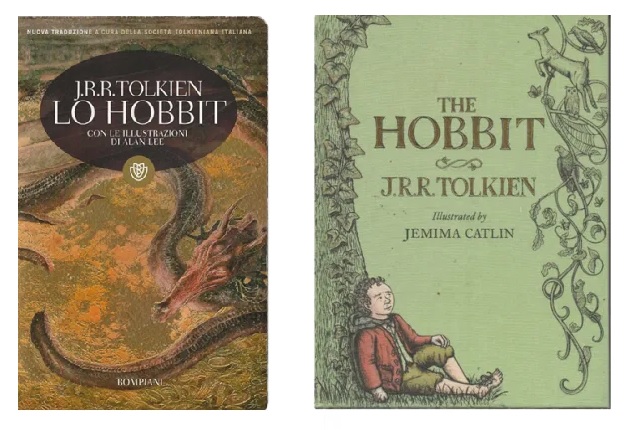
Also, what about costumes? Cosplay for conventions or moots or film parties? Or for Halloween? Let’s see your best hobbit impressions, if you’ve got them!
Happy Hobbit Day and Tolkien Week!
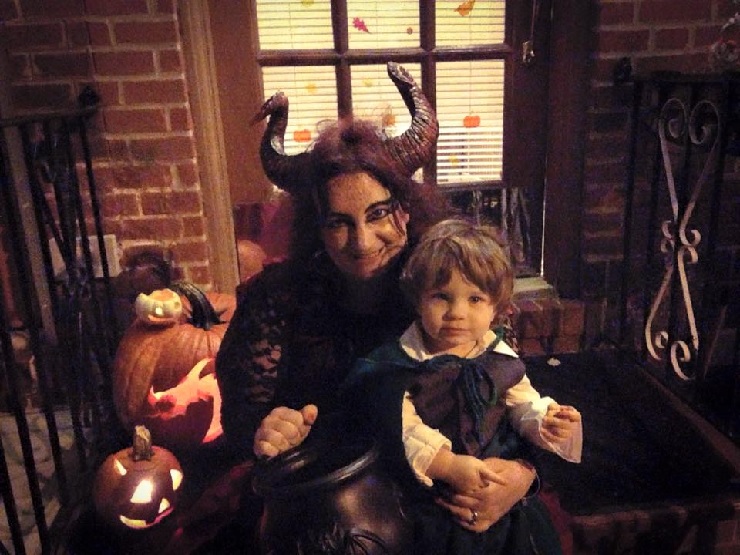
Top image from “Then There Were Three” by Donato Giancola.
Jeff LaSala can’t leave Middle-earth well enough alone, as evidenced by his Silmarillion Primer and now Deep Delvings articles. Tolkien geekdom aside, Jeff wrote a Scribe Award–nominated D&D novel, produced some cyberpunk stories, and now works for Tor Books. He sometimes flits about on Twitter.










